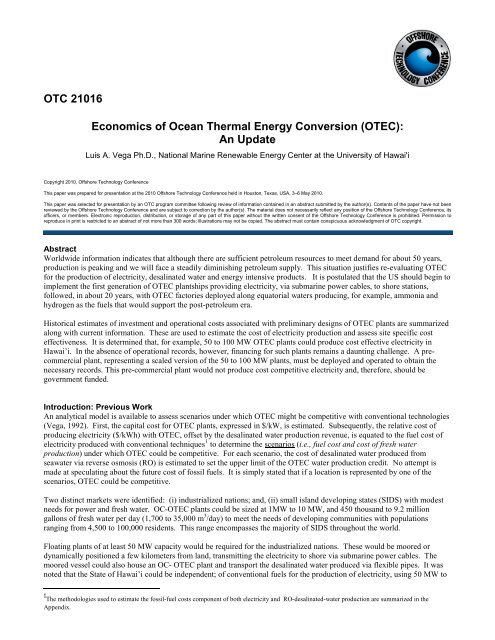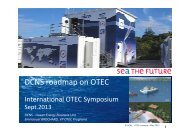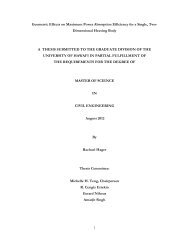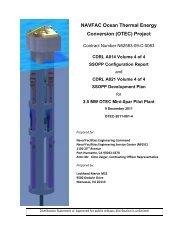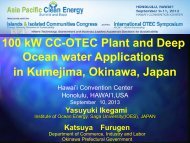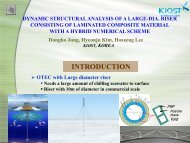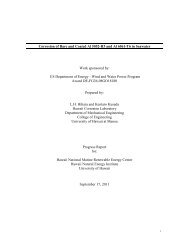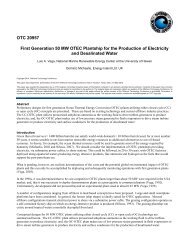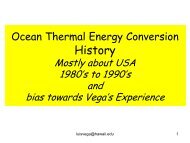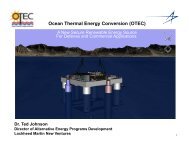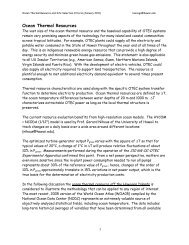OTEC Economics 2010 - Hawaii National Marine Renewable ...
OTEC Economics 2010 - Hawaii National Marine Renewable ...
OTEC Economics 2010 - Hawaii National Marine Renewable ...
- No tags were found...
Create successful ePaper yourself
Turn your PDF publications into a flip-book with our unique Google optimized e-Paper software.
OTC 21016<strong>Economics</strong> of Ocean Thermal Energy Conversion (<strong>OTEC</strong>):An UpdateLuis A. Vega Ph.D., <strong>National</strong> <strong>Marine</strong> <strong>Renewable</strong> Energy Center at the University of Hawai'iCopyright <strong>2010</strong>, Offshore Technology ConferenceThis paper was prepared for presentation at the <strong>2010</strong> Offshore Technology Conference held in Houston, Texas, USA, 3–6 May <strong>2010</strong>.This paper was selected for presentation by an OTC program committee following review of information contained in an abstract submitted by the author(s). Contents of the paper have not beenreviewed by the Offshore Technology Conference and are subject to correction by the author(s). The material does not necessarily reflect any position of the Offshore Technology Conference, itsofficers, or members. Electronic reproduction, distribution, or storage of any part of this paper without the written consent of the Offshore Technology Conference is prohibited. Permission toreproduce in print is restricted to an abstract of not more than 300 words; illustrations may not be copied. The abstract must contain conspicuous acknowledgment of OTC copyright.AbstractWorldwide information indicates that although there are sufficient petroleum resources to meet demand for about 50 years,production is peaking and we will face a steadily diminishing petroleum supply. This situation justifies re-evaluating <strong>OTEC</strong>for the production of electricity, desalinated water and energy intensive products. It is postulated that the US should begin toimplement the first generation of <strong>OTEC</strong> plantships providing electricity, via submarine power cables, to shore stations,followed, in about 20 years, with <strong>OTEC</strong> factories deployed along equatorial waters producing, for example, ammonia andhydrogen as the fuels that would support the post-petroleum era.Historical estimates of investment and operational costs associated with preliminary designs of <strong>OTEC</strong> plants are summarizedalong with current information. These are used to estimate the cost of electricity production and assess site specific costeffectiveness. It is determined that, for example, 50 to 100 MW <strong>OTEC</strong> plants could produce cost effective electricity inHawai’i. In the absence of operational records, however, financing for such plants remains a daunting challenge. A precommercialplant, representing a scaled version of the 50 to 100 MW plants, must be deployed and operated to obtain thenecessary records. This pre-commercial plant would not produce cost competitive electricity and, therefore, should begovernment funded.Introduction: Previous WorkAn analytical model is available to assess scenarios under which <strong>OTEC</strong> might be competitive with conventional technologies(Vega, 1992). First, the capital cost for <strong>OTEC</strong> plants, expressed in $/kW, is estimated. Subsequently, the relative cost ofproducing electricity ($/kWh) with <strong>OTEC</strong>, offset by the desalinated water production revenue, is equated to the fuel cost ofelectricity produced with conventional techniques 1 to determine the scenarios (i.e., fuel cost and cost of fresh waterproduction) under which <strong>OTEC</strong> could be competitive. For each scenario, the cost of desalinated water produced fromseawater via reverse osmosis (RO) is estimated to set the upper limit of the <strong>OTEC</strong> water production credit. No attempt ismade at speculating about the future cost of fossil fuels. It is simply stated that if a location is represented by one of thescenarios, <strong>OTEC</strong> could be competitive.Two distinct markets were identified: (i) industrialized nations; and, (ii) small island developing states (SIDS) with modestneeds for power and fresh water. OC-<strong>OTEC</strong> plants could be sized at 1MW to 10 MW, and 450 thousand to 9.2 milliongallons of fresh water per day (1,700 to 35,000 m 3 /day) to meet the needs of developing communities with populationsranging from 4,500 to 100,000 residents. This range encompasses the majority of SIDS throughout the world.Floating plants of at least 50 MW capacity would be required for the industrialized nations. These would be moored ordynamically positioned a few kilometers from land, transmitting the electricity to shore via submarine power cables. Themoored vessel could also house an OC- <strong>OTEC</strong> plant and transport the desalinated water produced via flexible pipes. It wasnoted that the State of Hawai’i could be independent; of conventional fuels for the production of electricity, using 50 MW to1 The methodologies used to estimate the fossil-fuel costs component of both electricity and RO-desalinated-water production are summarized in theAppendix.
2 OTC 21016100 MW floating plants for the larger communities in Oahu, Kauai, Maui and the Island of <strong>Hawaii</strong>.The 1992 report also provided estimates for land-based 1 MW open cycle plants with and without second-stage desalinatedwater production as well as a plant with a system including the use of 90 kg/s of 6°C cold seawater as the chiller fluid for astandard air-conditioning unit supporting a 300 ton load (∼300 rooms). These plants would be designed utilizing the state-ofthe-art,bottom-mounted cold water pipe technology (Nihous et al, 1989). The report also included cost estimates for otherplants ranging from 10 to 100 MW. These have been extrapolated to present day costs and included in Table 2 below.It was also established that <strong>OTEC</strong>–based, mariculture operations and air-conditioning systems could only make use of a smallamount of the seawater available; and therefore, could only impact small plants. The use of energy carriers (e.g.: Hydrogen,Ammonia) to transport <strong>OTEC</strong> energy generated in floating plants, drifting in tropical waters away from land, was determinedto be technically feasible but requiring increases in the cost of fossil fuels of at least an order of magnitude (to about$400/barrel) to be cost effective.Presently, the external costs of energy production and consumption are not included in the determination of the charges to theconsumer. Considering all stages of generation, from initial fuel extraction to plant decommissioning, it has been determinedthat no energy technology is completely environmentally benign. The net social costs of the different methods of energyproduction continue to be a topic under study. Estimates of costs due to: corrosion, health impacts, crop losses, radioactivewaste, military expenditures, employment loss, subsidies (tax credits and research funding for present technologies) are foundin the literature. The range of all estimates is equivalent to adding from $80/barrel to over $400/barrel. Accounting for theseexternalities might eventually help the development and expand the applicability of <strong>OTEC</strong>, but in the interim the scenariosthat were identified in the original 1992 report should be considered again.Industry did not take advantage of the information because in the 1990’s the prices of oil fuels and coal were such thatconventional power plants produced cost-effective electricity (excluding externalities). Moreover, the power industry couldonly invest in power plants whose designs were based on similar plants with an operational record. It was concluded thatbefore <strong>OTEC</strong> could be commercialized, a prototypical plant must be built and operated to obtain the information required todesign commercial systems and to gain the confidence of the financial community and industry. Conventional power plantspollute the environment more than an <strong>OTEC</strong> plant would and the fuel for <strong>OTEC</strong> is vast and free, as long as the sun heats theoceans; however, it is futile to use these arguments to convince the financial community to invest in an <strong>OTEC</strong> plant withoutoperational records.Site Selection Criteria for <strong>OTEC</strong> PlantsThe search for marine renewable energy resources has resulted in <strong>OTEC</strong>’s second revival. As it is well know the conceptutilizes the differences in temperature, ∆T, between the warm (Tw ∼ 22 °C to 29 °C) tropical surface waters, and the cold (Tc∼ 4 °C to 5 °C) deep ocean waters available at depths of about 1,000 m, as the source of the thermal energy required. Thereare two approaches one referred to as "closed cycle" and the other as "open cycle." In the closed cycle, seawater is used tovaporize and condense a working fluid, such as ammonia, which drives a turbine-generator in a closed loop, producingelectricity. In the open cycle, surface water is flash-evaporated in a vacuum chamber. The resulting low-pressure steam isused to drive a turbine-generator. Cold seawater is used to condense the steam after it has passed through the turbine. Theopen cycle can, therefore, be configured to produce fresh water as well as electricity (Vega, 2003).The historical monthly averages of ∆T for February and August are depicted in Figures 1 and 2 respectively. Values arecolor coded as indicated in the right-hand-side of the Figures. The values were obtained by Prof. Gerard Nihous of theUniversity of Hawai’i from the <strong>National</strong> Ocean Data Center’s World Ocean Atlas (Nihous, <strong>2010</strong>). Deep seawater flows fromthe Polar Regions. These polar water, which represents up to 60% of all seawater, originates mainly from the Arctic for theAtlantic and North Pacific Oceans, and from the Antarctic (Weddell Sea) for all other major oceans. Therefore, Tc at a givendepth, approximately below 500 m, does not vary much throughout all regions of interest for <strong>OTEC</strong>. It is also a weakfunction of depth, with a typical gradient of 1°C per 150 m between 500 m and 1000 m. These considerations may lead toregard Tc as nearly constant, with a value of 4°C to 5°C at 1000 m.A desirable <strong>OTEC</strong> thermal resource of at least 20°C requires typical values of Tw of the order of 25°C. Globally speaking,regions between latitudes 20°N and 20°S are adequate. Some definite exceptions exist due to strong cold currents: along theWest Coast of South America, tropical coastal water temperatures remain below 20°C, and are often of the order of 15°C; asimilar situation prevails to a lesser extent for the West Coast of Southern Africa. Moreover, Tw varies throughout the year,and sometimes exhibits a significant seasonal drop due to the upwelling of deeper water induced by the action of the wind:such are the cases of the West Coast of Northern Africa in the winter (Figure 2). A careful <strong>OTEC</strong> site selection requires acomprehensive knowledge of local climate features inasmuch as they may affect Tw seasonally.
4 OTC 21016Figure 1.- Historical Monthly average of ∆T during February (Nihous, <strong>2010</strong>)Figure 2.- Historical Monthly average of ∆T during August (Nihous, <strong>2010</strong>).
OTC 21016 5GEOGRAPHICALAREA MAINLAND ISLAND____________________________________________________________________________________________________AMERICAS Mexico Guyana Cuba GuadeloupeBrazil Suriname Haiti MartiniqueColombia French Guiana Dominican Rep. BarbadosCosta Rica Nicaragua Jamaica DominicaGuatemala El Salvador Virgin Is. St. LuciaHonduras Belize Grenada St. KittsPanama United States St. Vincent BarbudaVenezuela Grand Cayman MontserratAntiguaThe GrenadinesPuerto RicoCuracaoTrinidad & Tobago ArubaBahamas____________________________________________________________________________________________________AFRICA Nigeria Gabon Sao Tome & PrincipeGhana Benin AscensionIvory Coast Zaire ComorosKenya Angola AldabraTanzania Cameroon MadagascarCongo MozambiqueGuinea Eq. GuineaSierra Leone TogoLiberia Somalia____________________________________________________________________________________________________INDIAN/PACIFICOCEAN India Australia Indonesia American SamoaBurma Japan Philippines Northern MarianasChina Thailand Sri Lanka GuamVietnam Hong Kong Papua New Guinea KiribatiBangladesh Brunei Taiwan French PolynesiaMalaysia Fiji New CaledoniaNauruDiego GarciaSeychellesTuvaluMaldivesWake Is.VanuatuSolomon Is.SamoaMauritiusTongaOkinawaCook Is.<strong>Hawaii</strong>Wallis & Futuna Is.Table 1.- List of Nations with Appropriate Ocean Thermal Resource within their 200 nautical milesExclusive Economic Zone (Vega, 1992).
6 OTC 21016<strong>OTEC</strong> Capital CostsCapital cost archival information, documented in <strong>Economics</strong> of Ocean Thermal Energy Conversion in 1992, was converted topresent day costs using the USA 20-year average for equipment price-index inflation. In addition, current technicalspecifications for 10, 50 and 100 MW <strong>OTEC</strong> plants were used by the author to solicit budgetary quotes. All estimates aresummarized in Table 2 and in Figure 3.Nominal Plant Size, Installed Capital Cost, Land/Floater Source(Extrapolated)MW-net$/kW1.4 41562 L Vega 19925 22812 L Jim Wenzel, 19955.3 35237 F Vega et al 199410 24071 L Vega 199210 18600 F This report35 12000 F "50 11072 F Vega 199253.5 8430 F This report100 7900 F "Table 2.- First Generation <strong>OTEC</strong> Plant Capital Cost Estimates: (i) Extrapolated Archival Estimates (1 – 50MW) and Current Estimates (10- 100 MW) in $/kW-net.These estimates are applicable for equipment purchased in USA, Europe or Japan and with installation by USA firms.Deployment and installation costs are included. One might speculate, based on the implementation of similar technologies,that later generation designs will reach cost reductions of as much as 30% . However, the premise herein is to indicate thatfirst generation plants can be cost effective under certain scenarios if the cost estimates presented here are met.With more detailed equipment information, the first generation design can be optimized and likely lead to lower capital costs.However, some potential suppliers of key components have been reluctant to provide the detailed information needed tooptimize the design. This is because, in the past, their <strong>OTEC</strong> work did not yield a single order (excluding the experimentalplants), mainly because there were no real customers for the technology. This situation will change if, for example, the USAFederal Government gets involved as outlined in the Conclusions Section (e.g., see Table 7).Figure 3 illustrates that <strong>OTEC</strong> capital cost ($/kW) is a strong function of plant size (MW). For convenience and futurereference a least-squares curve fit is provided:CC ($/kW) = 53,000 x MW -0.42
OTC 21016 7Figure 3.- Capital Cost Estimated for First Generation <strong>OTEC</strong> Plants.Capital Cost: 50 MW <strong>OTEC</strong> PlantshipDesigns for 50 MW <strong>OTEC</strong> first generation plants utilizing either closed cycle (CC) or open cycle (OC) technology arepresented in a separate paper at this conference (OTC # 20957). The capital costs estimated for these plants are summarizedin Table 3. The estimate for the CC-<strong>OTEC</strong> plant is $451M and for the OC-<strong>OTEC</strong> plant $551M. The CC-<strong>OTEC</strong> plant wouldrequire a 198 m long ship-shaped platform with 39 m beam and an operating draft of 16 m resulting in 120,600 tonne (metricton) displacement. The OC-<strong>OTEC</strong> plant would be shorter at 176 m but beamer at 90 m resulting in a displacement of 247,400tonnes.The plantship required for the CC-<strong>OTEC</strong> system is comparable to typical double-hulled vessels and could be constructed innumerous shipyards throughout the world. The OC-<strong>OTEC</strong> system, incorporating desalinated water production, requires avessel that is about three times wider (beam direction) than the standard tanker and container ships and might limit thenumber of shipyards with appropriate fabrication capabilities.The combined needs for large amounts of cold seawater (138.6 m 3 /s), and minimal pumping power losses result in arelatively large diameter CWP. A 1,000 m long 8.7 m i.d. fiber-reinforced-plastic (FRP) sandwich construction CWP isselected. This will be attached to a gimbal at midship. Applicable single point mooring systems, including electrical andfluid swivels, are available from the offshore industry. The Aluminum plate-fin heat exchangers considered for the ammoniacycle can be manufactured in the USA. The electricity is transmitted to shore via a submarine power cable and thedesalinated water via a flexible pipe (e.g., hose). Several firms manufacture the submarine power cable required for the<strong>OTEC</strong> plant.
8 OTC 21016Closed CycleSize: 53.5 MW-netDate: Feb 2009Component $M $/kW Percentage Ops 1st Year ($M) Replacement 1st Year ($M)Floating Vessel 100 1869 22% 3.3Mooring 24 449 5% 0.8Submarine Power Cable (10 km) 41 766 9% 1.4Seawater Pipes Installed 60 1121 13% 2.0Seawater Pumps Installed 24 449 5% 1.6Power Block (15 MW-gross Modules)Heat Exchangers 95 1776 21% 6.3Turbine-Generator 33 617 7% 2.2Electrical/NH3/Cl2/Controls 31 579 7% 1.0Installation Mechanical & Electrical 43 804 10% 1.4All Components Total: 451 8430 100% 3.4 20.1Notes:Capital Cost* Vega's archival information for USA/Japan/EU Manufacturers.* At Conceptual Level the CC for Open Cycle will double cost of Floating Vessel.* Assume the sum of all other cost are equivalent to Closed Cycle. Therefore,the CC for the Open Cycle Plant is $ 551M15-year30-yearOperations, Maintenance, Repair and Replacement (OMR&R)* A total staff of 17 is required to manage and operate floating plant in shifts 24/7Using USA Labor Rates the O&M portion for the first year is $ 3.4M (for both OC-<strong>OTEC</strong> and CC-<strong>OTEC</strong>)* To estimate the R&R portion for the first year: Pumps, HXs and T-G replaced in 15-yearsall other components in 30-years.First year estimate for R&R portion is (as given in Table) $ 20.1M for CC-<strong>OTEC</strong> and 23.4 for OC-<strong>OTEC</strong>If vessel and HXs manufactured in China the R&R portion would be 17.7 instead of 20.1Table 3.- 50 MW CC-<strong>OTEC</strong> and OC-<strong>OTEC</strong> Capital Cost Estimates.Given that the cost of a ship-shaped vessel is proportional to displacement it is safe to assume that the OC-<strong>OTEC</strong> platformsubsystem (excluding other subsystems) would cost twice as much as the CC-<strong>OTEC</strong> platform. Costs associated with allother subsystems (e.g., power block, seawater pipes, pumps, submarine power cable, mooring and positioning) areapproximately the same for the CC-<strong>OTEC</strong> and the OC-<strong>OTEC</strong> designs. Therefore, the capital cost estimate of the OC-<strong>OTEC</strong>design is higher by an amount given by the platform cost differential. It follows that concept selection is site specificdepending on the value of the desalinated water product.The CC-<strong>OTEC</strong> plant could support a population of 500,000 with a per capita daily consumption of 2.3 kWh. This value isrepresentative of the all encompassing per capita consumption in developing countries like the Philippines. In addition, theOC-<strong>OTEC</strong> system could also supply 240 l/day per capita. The per capita water consumption in the Philippines, for example,is estimated at 160 l/day in the domestic sector and 940 l/day for all sectors (i.e., domestic, industrial and agricultural).Electricity and desalinated water production rates are given in the following Table. The products are 432,609 MWh/year forthe CC-<strong>OTEC</strong>; and, 414,415 MWh/year and 118,434 m 3 /day for the OC-<strong>OTEC</strong>.
OTC 21016 9System Electricity Water Capital CostMWh/year m^3 / day$/kWnetClosed Cycle 432,609 0 8,430(53.5 MW)Open Cycle 414,415 118,434 10,751(51.25 MW)(1485 kg/s)<strong>OTEC</strong> Operational Costs and Cost of ProductionThe methodology used to estimate the cost of electricity production (COE) is documented in the Appendix. The COE isdefined by adding the amortized annual capital-loan repayment divided by the annual production ($/kWh) to the annuallevelized cost incurred due to operations, maintenance, repair and equipment replacement (OMR&R) divided by the annualelectricity production ($/kWh). Figure 4 and Table 4 summarize the COE in US cents (c) per kilowatt-hour (kWh) for firstgeneration plants.These levelized costs were estimated for an 8%, 15-year commercial loan. Figure 4 also includes the COE for a capitalimprovement loan based on government bonds (e.g., in Hawai’i a 4.2%, 20 year rate is realistic). Al cases consider a fixedinflation rate of 3% 2 . Figure 4, for example, can be used to determine the CC-<strong>OTEC</strong> plant size that would be cost competitivein an specific location. Presently, in Hawai’i, for example, COEs less than about 20 c/kWh must be achieved and, therefore,plants larger that about 50 MW are required. In the case of American Samoa, a 35 MW plant (not included in Figure 4)would be cost competitive producing about 282,000 MWh to meet current and forecast demand under a power-purchaseagreementat 25 c/kWh for 15-years.<strong>OTEC</strong> in Hawai’i and US Insular TerritoriesThe assessment of the ocean thermal resource off Hawai’i clearly shows that <strong>OTEC</strong> plants could supply all the electricity andpotable water consumed in the State (http://hinmrec.hnei.hawaii.edu/). This is the only indigenous renewable energyresource that can provide a high degree of energy security to the State and in addition minimize green house gas emissions.This statement is also applicable to all US Insular Territories (e.g., American Samoa, Guam, Northern Mariana Islands,Virgin Islands and Puerto Rico).Over a decade ago, the detailed evaluation of economic feasibility and financial viability of <strong>OTEC</strong> revealed that, for example,in Hawai’i plants would have to be sized at about 50 to 100 MW to produce electricity at a price corresponding to theUtility’s avoided cost . Smaller plants were not cost effective in Hawai’i. It was also concluded that, although experimentalwork with relatively small plants had unambiguously demonstrated continuous production of electricity (Steinbach, 1982;Vega, 1995) and desalinated water (Vega, 1995), it would be necessary to build a pre-commercial plant sized around 5 MWto establish the operational record required to secure financing for the commercial size plants. The pre-commercial plantwould produce relatively high cost electricity and desalinated water such that support funding was required from the federaland state governments. Unfortunately, development did not proceed beyond experimental plant sized at less than 0.25 MW(Vega, 2003).In the mid 90s a group led by the author designed a 5 MW pre-commercial plant and made the information available in thepublic domain (Vega et al, 1994). However, because the price of petroleum fuels was relatively low and fossil fuels wereconsidered to be abundantly available, government funding for the pre-commercial plant could not be obtained. Directextrapolation from the experimental plants to commercial sizes, bypassing the pre-commercial stage, would have required aleap of faith with high technical and economic risks that no financial institution was willing to take.2 this corresponds to the 20-year USA average: 1988-2007.
10 OTC 21016In Hawai’i a 100 MW <strong>OTEC</strong> plant, for example, could be housed in a floating platform stationed less than 10 km offshore,and would have the capability of delivering 800 million kWh to the electrical grid every year. Budgetary quotes frompotential equipment suppliers indicate that the installed cost would be $790 million using state-of-the-art components (Table2). The annual costs for operations and maintenance are estimated at $40 million (Table 4) such that under realistic financingterms (15 year loan at 8% annual interest and 3% average annual inflation) electricity could be produced at a levelized cost ofless than 0.18 $/kWh such that a realistic power-purchase-agreement from the utility 3 at around 0.20 $/kWh would includeample return on investment. It is interesting to note that if the plant could be funded via government bonds at a realistic rateof 4.2% over 20 years the COE would be 0.14 $/kWh (Figure 4).Figure 4.- Cost of Electricity (Capital Cost Amortization + OMR&R Levelized Cost) Production for First Generation <strong>OTEC</strong> Plants as afunction of Plant Size with Loan Terms (interest and term) as Parameter. Annual Inflation assumed constant at 3%.3 Presently, the electrical utilities in the state of Hawai’i can purchase baseload (dispatchable) capacity for as much as 0.20 $/kWh.
OTC 21016 11Identifier NominalSize, MWCapital Cost,$/kWO&M, $M/yearR&R,$M/yearCOECC,c/kWhCOE OMR&R,c/kWhCOE,c/kWh1.35 41,562 2.0 1.0 60 33.7 94.05 22,812 2.0 3.5 33 17 50.010 18,600 3.4 7.7 26.9 16.8 44.053.5 8,430 3.4 20.1 12.2 6.7 19.0100 7,900 3.4 36.5 11.4 6 18.08%/15 yearsTable 4.- Levelized COE (US-cents/kWh) for CC-<strong>OTEC</strong> Plants (no desalinated water production) withCapital Costs (CC) Amortized through an 8%/15 Year Loan and Annual Inflation at 3%, considering USALabor Rates (O&M) and First Year Repair and Replacement Cost (R&R) as Indicated. First two entries areLand Based as indicated by lower O&M (see Table 2).<strong>Economics</strong> of 50 MW <strong>OTEC</strong> PlantsUsing as input the updated capital costs given in Table 3 for 50 MW plants, the levelized costs of production weredetermined for the CC-<strong>OTEC</strong> plant (Table 5). In the case of the OC-<strong>OTEC</strong> plant the combination of electricity rate ($/kWh)and desalinated water rate ($/m 3 ) required to breakeven were estimated (Table 6).An 8% loan over 15 years was considered for the capital investment and for the OMR&R costs current-dollar levelizationwas evaluated at a fixed annual inflation rate of 3%. For continuous operation of <strong>OTEC</strong> plantships, a crew of seventeen fulltimeemployees would be required. This includes one administrator and sixteen operators for the power plant and the shipsystems. Eight operators would be on duty at one time while the other eight rest. The administrator works a regularschedule. Using USA labor rates the fully loaded annual salary costs would be ≈ $3.4 M. This figure is taken as the firstyear operation & maintenance portion (OM) of recurring costs; and, based on replacement costs for the capital investment(Table 3), the first year annual costs associated with repair and replacement (R&R) are taken as: $20.1 M for the CC-<strong>OTEC</strong>plant (Table 5); and, $23.4M for the OC-<strong>OTEC</strong> plant (Table 6).As shown in Table 5, excluding profits and credits, the breakeven point (defined as: levelized annual costs = annual revenue)for the 50 MW CC-<strong>OTEC</strong> plant is given by a 15-year power-purchase-agreement for at least 0.19 $/kWh.In the case of the OC-<strong>OTEC</strong> plant, there are two (of many) scenarios that illustrate the breakeven point:(i) sell electricity for at least 0.15 $/kWh; and water for 0.8 $/m 3 (3 $/kgallon) {see Table 6}(ii) sell electricity for at least 0.07 $/kWh; and water for 1.6 $/m 3 (6 $/kgallon)It must be emphasized that the economic analysis summarized here is based in capital and operational cost applicable in theUSA.
12 OTC 21016Table 5.- CC-<strong>OTEC</strong>: Levelized Cost of Electricity Production.
OTC 21016 13Table 6.- OC-<strong>OTEC</strong>: Breakeven Electricity and Water Rates Required {one of many scenarios given herewith 0.152 $/kWh and 0.8 $/m 3 (3 $/kilogallon)}.
14 OTC 21016Conclusions and RecommendationsThe major conclusion reached in the earlier report continues to be applicable: there is a market for <strong>OTEC</strong> plants thatproduce electricity and desalinated water, however, operational data must be obtained by building and operatingdemonstration plants scaled down from sizes identified as cost effective. <strong>OTEC</strong> systems are in the pre-commercial phasewith several experimental projects having already demonstrated that the technology works but lacking the operational recordsrequired to proceeding into commercialization. Adequately sized pilot projects must be operated in situ and for at least onecontinuous year to obtain these records. Our analysis indicates that a pre-commercial or demonstration plants sized at about5 MW must be operated prior implementation of 50 to 100 MW commercial plants.Accounting for externalities in the production and consumption of electricity and desalinated water might eventually help thedevelopment and expand the applicability of <strong>OTEC</strong>. Unfortunately, it is futile to use these arguments to convince thefinancial community to invest in <strong>OTEC</strong> plants without an operational record.The major challenge continues to be the requirement to finance relatively high capital investments that must be balanced bythe expected but yet to be demonstrated low operational costs. Perhaps a lesson can be learned from the successfulcommercialization of wind energy due to consistent government funding of pilot or pre-commercial projects that led toappropriate and realistic determination of technical requirements and operational costs in Germany, Denmark and Spain. Inthis context, by commercialization we mean that equipment can be financed under terms that yield cost competitiveelectricity. This of course depends on specific conditions at each site. Presently, for example, in Hawai’i cost competitivenessrequires electricity produced at less than about 0.20 $/kWh. Our analysis indicates that, without subsidies or environmentalcredits, plants would have to be 50 MW or bigger to be cost competitive in Hawai’i.In discussing <strong>OTEC</strong>’s potential it is important to remember that implementation of the first plant would take about 5-yearsafter order is placed. This is illustrated with the baseline schedule shown in Table 7. The time required for each majoractivity also applies to the pre-commercial or demonstration plant. Completion of the engineering design with specificationsand shop drawings would take one-year. Presently it is estimated that the licensing and permitting process through NOAA(in accordance with the <strong>OTEC</strong> Act) would take longer than 2-years for commercial plants with the provision of exemptionsfrom the licensing process for plants considered to be demonstration plants because of the limited duration of the operationalphase.A survey of factories that can supply all equipment required for the <strong>OTEC</strong> systems discussed above shows that no technicalbreakthroughs are required but that some components would require as long as 3-years to be delivered after the order isplaced. The solicitation of equipment quotes based on technical specifications, as it was done in preparation of this report,indicates that long-lead items would require from 18-months to 36-months to be delivered. Based on experience withoffshore projects of similar size it is expected that one-year would be required to complete the deployment with a second yearset aside for commissioning.Table 7.- First Generation <strong>OTEC</strong> Plantship Implementation Schedule.
OTC 21016 15As stated above, there are sufficient petroleum resources to meet demand for at most 50 years and with production peakingwe will face a steadily diminishing petroleum supply. This situation justifies re-evaluating <strong>OTEC</strong> for the production ofelectricity as well as energy intensive products. The US should begin to implement the first generation of <strong>OTEC</strong> plantshipsproviding electricity, via submarine power cables, to shore stations. This would be followed, in about 20 years, with <strong>OTEC</strong>factories deployed along equatorial waters producing, for example, ammonia and hydrogen as the fuels that would supportthe post-petroleum era.The following Development Schedule can be used as an outline of the activities required to implement ocean thermalresources as a major source of energy for our post-petroleum future. A pre-commercial plant would be implemented with USgovernment funding. The plant would be operational (supplying electricity to the distribution grid) within 5-years and wouldbe operated for a few years to gather technical as well as environmental impact information. Some of the valid questionsregarding potential environmental impacts to the marine environment can only be answered by operating plants that are largeenough to represent the commercial-size plants of the future.The design of the first commercial plant sized at 50 to 100 MW would be completed and optimized after the first year ofoperations with the pre-commercial plant. This would be followed with the installation of numerous plants in Hawai’i and USInsular Territories for a cumulative total of about 2,000 MW over 15-years. As indicated in Table 8, the design of thegrazing factory plantships that will produce the fuels of the future (e.g., hydrogen and ammonia) could be initiated as early as15-years after the development program is implemented.Table 8.- <strong>OTEC</strong> Implementation Program Required in Preparation for thePost-Petroleum Age.
16 OTC 21016ReferencesNihous, G.C. (<strong>2010</strong>), Personal Communication: Information about Global Ocean Thermal Energy Resources from amanuscript under preparation.Nihous, G.C. and Vega, L.A. (1993), “Design of a 100 MW <strong>OTEC</strong>-Hydrogen Plantship,” <strong>Marine</strong> Structures 6 (1993), pp207-221, published by Elsevier Science Publishers Ltd. England.Nihous, G.C., Syed, M.A., and Vega, L.A., (1989), "Conceptual Design of a Small Open–Cycle <strong>OTEC</strong> Plant for theProduction of Electricity and Fresh Water in a Pacific Island," Proceedings, International Conference on Ocean EnergyRecovery, Honolulu, <strong>Hawaii</strong>, November 1989, published by the American Society of Civil Engineers.Steinbach, R.B. (1982), “Mini-<strong>OTEC</strong>: A Hardware Perspective,” Society of Naval Architects and <strong>Marine</strong> Engineers SpringMeeting, April 1982, Honolulu, <strong>Hawaii</strong>, pp 289-306.Syed M.A., Nihous G.C., and Vega L.A. (1991), “Desalinated Water Production with Flash Evaporators and SurfaceCondensers Developed for OC-<strong>OTEC</strong> Applications,” Oceans ‘91, Honolulu, <strong>Hawaii</strong>.Syed M.A., Nihous G.C., and Vega L.A. (1991), “Use of Cold Seawater for Air Conditioning”, Oceans ‘91, Honolulu,<strong>Hawaii</strong>.Vega L. (2003), “Ocean Thermal Energy Conversion Primer”, <strong>Marine</strong> Technology Society Journal, Vol. 6, No. 4, Winter2002/2003, pp. 25-35.Vega, L.A. (1995), “The 210 kW Apparatus: Status Report,” Oceans ’95 Conference, October 1995, San Diego, California.Vega, L.A. and Nihous, G.C. (1994), “Design of a 5 MWe <strong>OTEC</strong> Pre-Commercial Plant,” Proceedings OceanologyInternational ’94 Conference, Brighton, England, March 1994.Vega L.A. (1992), “<strong>Economics</strong> of Ocean Thermal Energy Conversion (<strong>OTEC</strong>)” in R.J. Seymour, ed. Ocean EnergyRecovery: The State of the Art, American Society of Civil Engineers, New York.
OTC 21016 17Appendix• Conventional Production of ElectricityThe thermal efficiency (η) of a well maintained conventional steam power plants, fired with oil or coal can be as high as36%. This implies that 36% of the heat added is converted to net work. Net work is defined as the difference between theoutput from the turbine-generator and the work required to run the plant.The convention followed in power plant technology, to express plant performance, is to consider the heat added to produce aunit amount of net work. This parameter is called the heat rate (HR) of the plant and is usually given in Btu/kWh. Therefore,the heat rate is inversely proportional to the thermal efficiency, η = 3413/HR (i.e., 1 kWh = 3413 Btu at 60°F), such that athermal efficiency of 36% corresponds to a HR of 9500 Btu/kWh. [Herein common usage dictates the use of mixed units.]The heating values of standard coal and fuel oil are 12,000 x (1 ± 0.17) Btu/lbm and 144,000 x (1 ± 0.04) Btu/U.S. gallon,respectively. Therefore, within 6%, the fuel cost incurred in producing electricity, expressed in $/kWh, with an oil-fired plantis:COE fuel = 1.6 x 10 -3 x CB,CB is the Cost of a (42 U.S. gallons) Barrel of fuel.Therefore, for example, at $62.5 per barrel the COE fuel is 0.10 $/kWh.The same expression can be used for diesel generators without a loss of generality.In the case of coal, the standard heating value is 12,500 Btu/lbm with a current price of about $62 per metric ton such that thefuel cost incurred in producing electricity with a thermal efficiency of 36% would be 0.021 $/kWh. This is equivalent to oilfuel cost of $13/barrel.To estimate the total cost of electricity production the COE fuel must be added to the capital cost as well as costs associatedwith OMR&R .• Conventional Production of Desalinated WaterFor convenience and because the first generation <strong>OTEC</strong> plants are expected to be deployed around islands it is assumed thatthe cost of seawater desalination with <strong>OTEC</strong> must be compared with that of reverse osmosis (RO) desalination of seawater.RO plants require energy solely as shaft power from, for example, an electric motor. It can be shown that, expressed in $/m 3 ,fresh water production by RO costs 0.049 x CB, where CB is the cost of a barrel of fuel. This expression was used in theprevious report to establish the desalinated water cost corresponding to a given fuel cost scenario (Vega, 1992).• Levelized Cost of Electricity: MethodologyThe levelized cost of electricity (COE) expressed in constant annual cost is given by the sum of the levelized investment cost(i.e., the loan amortization payment expressed in $/kWh) and the levelized operations, maintenance, repair and replacement(OMR&R) expense cost.Referring to Table 5, the following terms are defined:System Net Name Plate (MW): <strong>OTEC</strong> system net power is inputted based on design specific conditions (53.5 MW-net);System (equipment) Availability: The percentage of time that system is available. Based on experimental data it is assumedthat this system consists of five modules with annual maintenance downtime of 4-week per module such that annualavailability is 0.923 (92.3%);Site Annual (resource) Capacity Factor: To account for resource variability. In this case 100% because design alreadyaccounted for resource variability (accounted for by the selection of name plate, in this case for a site, with constant Tc andTw ranging from 24 °C to 28 °C throughout year). This parameter is used for evaluation of intermittent resources like windand waves;Annual Electricity Production (MWh): Name Plate x Availability x Capacity Factor x 8760;
18 OTC 21016Daily Desalinated Water Production (MGD; m 3 /day): Used for OC-<strong>OTEC</strong> systems (e.g., see Table 6);Installed Cost (Capital Cost, CC): This is the amount (given in million dollars) of the loan: inputted cost estimate {given in$/kW from Table 2 (or Table 3 as appropriate)} times the Name Plate;First Year OMR&R: Estimated as illustrated in Table 3 (in million dollars) to account for the funds that must be collected tocover all operational costs;Interest (I): From the loan term (herein 8% is assumed for a commercial loan and 4.2% for government bonds);Escalation (Inflation) Rate: taken at a constant 3% in this report;System Life (N): As a conservative assumption, this is defined as the loan term (15 years for the commercial loan; and 20-years for the bonds) although the <strong>OTEC</strong> system is designed for a 30-year useful life. As illustrated in Table 3, for example,some components are replaced in 15-year intervals others require 30-year intervals;Under Capital Payment (loan amortization):Capital Recovery Factor (CRF):CRF = [I x(1 + I) N ]/[(1+I) N -1]such that for parameters in Table 5 the CRF is 0.1168;Levelized Investment Cost: Amount ($) required yearly to pay capital loan: CC x CRF;Fixed Capital Cost Component of Cost of Electricity ($/kWh): Levelized Investment Cost/Annual Electricity Production.This is the amount that must be collected per kWh produced to pay the loan;Under OMR&R Costs (levelized costs):Present Worth Factor (PWF):WF = [ (1 +ER)/(I – ER)]/[1 – {(1 + ER)/(1 + I)} N ]such that for parameters given in Table 5 the PWF is 10.48 years;Expenses Levelizing Factor (ELF):ELF = PWF x CRFsuch that for the parameters given in Table 5 the levelizing factor is 1.22;Levelized Expenses Cost: The fixed amount that must be collected yearly to cover all OMR&R costs accounting for inflation.This is equal to the amount estimated for the first year (as given above) times the ELF. For the parameters and estimatesgiven in Table 5 the value is 22% higher of what would be required the first year;Levelized OMR&R Component of COE ($/kWh): The levelized expenses cost ($) divided the annual production ofelectricity (kWh);Total Levelized Cost of Electricity ($/kWh): This is the sum of COE CC and COE OMR&R ; The value given here excludesenvironmental credits, tax credits and profit.


